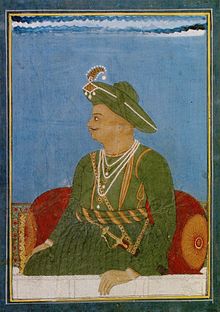
Back Tipu Sultan Afrikaans السلطان تيبو Arabic السلطان تيبو ARZ টিপু চুলতান Assamese Tipu Sultan Azerbaijani تیپو سولطان AZB Тыпу Султан Byelorussian Тыпу Султан BE-X-OLD Типу Султан Bulgarian टीपू सुल्तान Bihari
| Tipu Sultan | |||||
|---|---|---|---|---|---|
| Badshah Nasib-ud-Daulah Mir Fateh Ali Bahadur Tipu | |||||
 Portrait of Tipu Sultan, from Mysore (c. 1790–1800). | |||||
| Sultan of Mysore | |||||
| Reign | 10 December 1782 – 4 May 1799 | ||||
| Coronation | 29 December 1782 | ||||
| Predecessor | Hyder Ali | ||||
| Successor | Krishnaraja III (as Maharaja of Mysore) | ||||
| Born | Sultan Fateh Ali Sahab Tipu 1 December 1751 Devanahalli, Kingdom of Mysore (modern-day Karnataka, India) | ||||
| Died | 4 May 1799 (aged 47) Srirangapatna, Sultanate of Mysore (modern-day Karnataka, India) | ||||
| Burial | |||||
| Spouse |
Sultan Begum Sahib (m. 1774)Ruqaya Banu Begum (m. 1774)Khadija Zaman Begum
(m. 1796; died 1797)Buranti Begum Roshani Begum | ||||
| Issue | Shezada Hyder Ali, Ghulam Muhammad Sultan Sahib and many others | ||||
| |||||
| House | Mysore | ||||
| Father | Hyder Ali | ||||
| Mother | Fatima Fakhr-un-Nisa | ||||
| Religion | Shia Islam[1] | ||||
| Seal |  | ||||
Tipu Sultan (Sultan Fateh Ali Sahab Tipu; 1 December 1751 – 4 May 1799), commonly referred to as Sher-e-Mysore or "Tiger of Mysore",[2][3] was the Indian Muslim ruler of the Kingdom of Mysore based in South India.[4] He was a pioneer of rocket artillery.[5][6][7] He expanded the iron-cased Mysorean rockets and commissioned the military manual Fathul Mujahidin. He deployed the rockets against advances of British forces and their allies during the Anglo-Mysore Wars, including the Battle of Pollilur and Siege of Srirangapatna.[8]
Tipu Sultan and his father Hyder Ali used their French-trained army in alliance with the French in their struggle with the British,[9] and in Mysore's struggles with other surrounding powers: against the Marathas, Sira, and rulers of Malabar, Kodagu, Bednore, Carnatic, and Travancore. Tipu became the ruler of Mysore upon his father's death from cancer in 1782 during the Second Anglo-Mysore War. He negotiated with the British in 1784 with the Treaty of Mangalore which ended the war in status quo ante bellum.
Tipu's conflicts with his neighbours included the Maratha–Mysore War, which ended with the signing of the Treaty of Gajendragad.[10]
Tipu remained an enemy of the British East India Company. He initiated an attack on British-allied Travancore in 1789. In the Third Anglo-Mysore War, he was forced into the Treaty of Seringapatam, losing a number of previously conquered territories, including Malabar and Mangalore. In the Fourth Anglo-Mysore War, a combined force of British East India Company troops supported by the Marathas and the Nizam of Hyderabad defeated Tipu. He was killed on 4 May 1799 while defending his stronghold of Seringapatam.
Tipu also introduced administrative innovations during his rule, including a new coinage system and calendar,[11] and a new land revenue system, which initiated the growth of the Mysore silk industry.[12] He is known for his patronage to Channapatna toys[13].
- ^ Stearns, Peter (2008). The Oxford Encyclopedia of the Modern World,Volume 4. Oxford University Press, 2008. p. 243. ISBN 9780195176322.
- ^ Cavendish, Richard (4 May 1999). "Tipu Sultan killed at Seringapatam". History Today. 49 (5). Retrieved 13 December 2013.
- ^ Brittlebank, Kate (2022). Tiger: The Life of Tipu Sultan. Claritas Books. ISBN 978-1-905837-87-8. Retrieved 15 April 2024. Quote=Aer he died, it became his epithet – 'the Tiger of Mysore' the British called him.
- ^ Yazdani, Kaveh (2017). India, Modernity and the Great Divergence. Brill. p. 67. ISBN 9789004330795.
- ^ Colley, Linda (2000). "Going Native, Telling Tales: Captivity, Collaborations and Empire". Past & Present (168): 190. ISSN 0031-2746. JSTOR 651308.
- ^ Dalrymple 2019, p. 243.
- ^ Jamil, Arish. "Why Mysore? The Idealistic and Materialistic Factors Behind Tipu Sultan's War Rocket Success" (PDF). Emory Endeavors in World History - Volume 5. Emory College of Arts and Science. Retrieved 21 May 2022.
- ^ Cite error: The named reference
Narasimhawas invoked but never defined (see the help page). - ^ Roy 2011, p. 77.
- ^ Hasan 2005, pp. 105–107.
- ^ Hasan 2005, p. 399.
- ^ Datta, R.K. (2007). Global Silk Industry: A Complete Source Book. APH Publishing. p. 17. ISBN 978-81-313-0087-9.
- ^ "History Of Channapatna Toys". Craftdeals.in. January 2023. Retrieved 1 January 2023.
© MMXXIII Rich X Search. We shall prevail. All rights reserved. Rich X Search